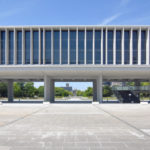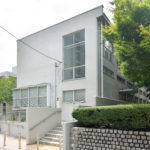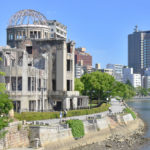column 4 Hiroshima in Movies
Introduction
“You saw nothing in Hiroshima.” A line Japanese architect delivers to a French actress who has fallen in love with him in Hiroshima in the opening scene of Hiroshima mon amour (1959), directed by Alain Resnais. The architect cut her off just as she utters, “I saw everything.” It is one of the best internationally recognized films set in Hiroshima.
“You saw nothing in Hiroshima.” These words can be heard in other movies that capture the scenes of the city. The details of the onscreen images and the subtleties of the drama introduce the audience to an unknown Hiroshima. Below are some of the films that have remained powerful in that they renew the memories of what happened in Hiroshima.
1. Encounter with memories and realism
In Hiroshima mon amour, released in Japan under the title of Nijuyojikan no Joji (A Love Affair in 24 hours), is a film about an architect—who lost his family in the atomic bombing—and an actress—who was shunned by other French people for falling in love with an enemy soldier—who exchange memories of their hurtful pasts. The story was described in a delicate manner along with the scenery of Hiroshima in 1958 and it seems to show the beginnings of recapturing the memories of Hiroshima in a global context. This film uses scenes from another movie that shows the hellish scenes of Hiroshima directly after the atomic bombing. That film is Hiroshima (1953) by director Hideo Sekigawa. Shortly after the press code restrictions—enforced by the Allied Force—ended in 1952, many movies about the atomic bombing were be made in Japan. Hiroshima was one of the earliest movies depicting the bombing, made following Genbaku no ko (1952, Children of Hiroshima) which was directed by Kaneto Shindo. It should be mentioned that Hiroshima portrayed the horrible scenes of the bombing with utter realism by recruiting ninety thousand citizens from Hiroshima as extras. Its impact remains just as powerful today.
Shortly after the press code restrictions—enforced by the Allied Force—ended in 1952, many movies about the atomic bombing were be made in Japan. Hiroshima was one of the earliest movies depicting the bombing, made following Genbaku no ko (1952, Children of Hiroshima) which was directed by Kaneto Shindo. It should be mentioned that Hiroshima portrayed the horrible scenes of the bombing with utter realism by recruiting ninety thousand citizens from Hiroshima as extras. Its impact remains just as powerful today.
2. Memories of the bombing during the period of reconstruction
In 1960s, movies which focused on the city as reconstruction efforts progressed and those who lived there holding memories of the A-bombing were made. Among those was director Kozaburo Yoshimura’s Sono Yoru wa Wasurenai (1962, I Won’t Forget That Night), which does an impressive job of telling the feelings of a woman living in the entertainment district while hiding the hurt she suffered from the bombing. Hiroshima 1966 (1966), by director Kosei Shirai, is set during the Vietnam War and unforgettably portrays the story of a woman, who lost her husband in the bombing, and her daughter as they try to remove themselves from their difficult situation with the scenery of Hiroshima at the time. Director Kinji Fukasaku’s Jingi naki Tatakai (A fight without virtue) pentalogy, filmed in Hiroshima between 1973 and 1974, depicting the darker side of the reconstruction period through a cast of outlaws.
Conclusion
InA comparatively more recent film, Shohei Imamura’s Kuroi ame (1989, Black Rain), was based on the novel by Masuji Ibuse and deals with the uncertainty of the diseases that came with exposure to the atomic bomb. The film deserves to be reconsidered as a work that deeply resonates with those who experienced the catastrophe that took place at the Fukushima Daiichi Nuclear Power Station. Following this film, films about Hiroshima still continue to be made. Another film was Hiroshima Nagasaki (2007), which was directed by Steven Okazaki. This film shared the testimony of A-bomb survivors with the U.S.. The Mushroom Club (2005), which preceded Hiroshima Nagasaki, meticulously described those who living with the scars of the bombing in Hiroshima today. Films such as these reintroduce the tragedy that took place in Hiroshima, rekindle memories of the bombing, and serve as a precious opportunity to share the history of the reconstruction while we re-exam ourselves today.
(Nobuyuki Kakigi)
Inquiries about this page
Hiroshima Prefectural Office
Street address:10-52, Motomachi, Naka-ku, Hiroshima-shi, Hiroshima-ken, 730-8511
Tel:+81-(0)82-228-2111








